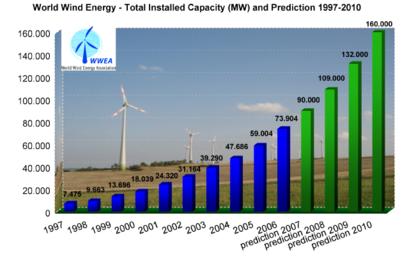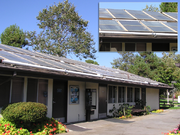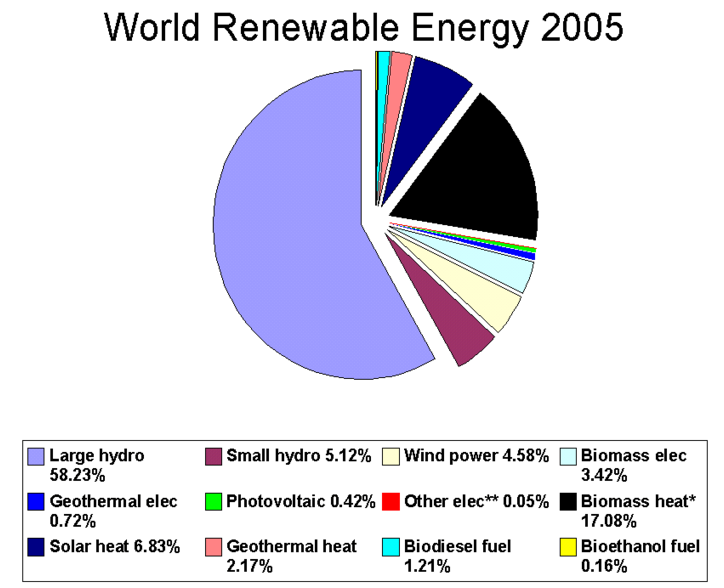Main
renewable energy technologies

Three energy sources
The majority of renewable energy
technologies are directly or indirectly powered by the
sun. The Earth-Atmosphere system is in equilibrium such
that heat radiation into space is equal to incoming
solar radiation, the resulting level of energy
within the Earth-Atmosphere system can roughly be
described as the Earth's "climate." The hydrosphere
(water) absorbs a major fraction of the incoming
radiation. Most radiation is absorbed at low latitudes
around the equator, but this energy is dissipated around
the globe in the form of winds and ocean currents. Wave
motion may play a role in the process of transferring
mechanical energy between the atmosphere and the ocean
through wind stress. Solar energy is also responsible
for the distribution of precipitation which is tapped by
hydroelectric projects, and for the growth of plants
used to create biofuels.
Renewable energy flows involve natural
phenomena such as sunlight, wind, tides and geothermal
heat, as the
International Energy Agency explains:
"Renewable energy is derived from
natural processes that are replenished constantly.
In its various forms, it derives directly from the
sun, or from heat generated deep within the earth.
Included in the definition is electricity and heat
generated from solar, wind, ocean, hydropower,
biomass, geothermal resources, and biofuels and
hydrogen derived from renewable resources."
Each of these sources has unique
characteristics which influence how and where they are
used.
Wind power

Offshore wind turbines near
Copenhagen
Airflows can be used to run wind
turbines. Modern wind turbines range from around 600kW
to up to 5 MW of rated power, although turbines with
rated output of 1.5-3 MW have become the most common for
commercial use. The power output of a turbine is a
function of the cube of the wind speed, so as wind speed
increases, power output increases dramatically. Areas
where winds are stronger and more constant, such as
offshore and high altitude sites, are preferred
locations for wind farms.
Wind power is the fastest growing of
the renewable energy technologies, though it currently
provides less than 0.5% of global energy. Over
the past decade, global installed maximum capacity
increased from 2,500 MW in 1992 to just over 40,000 MW
at the end of 2003, at an annual growth rate of near
30%. Due to the intermittency of wind resources, most
deployed turbines in the EU produce electricity an
average of 25% of the hours in a year (a capacity factor
of 25%), but under favorable wind regimes some reach 35%
or higher. Capacity factors are a function of seasonal
wind fluctuations and may be higher in winter. It would
mean that a typical 5 MW turbine in the EU would have an
average output of 1.7 MW.
Globally, the long-term technical
potential of wind energy is believed to be five times
total current global energy production, or 40 times
current electricity demand. This could require large
amounts of land to be utilized for wind turbines,
particularly in areas of higher wind resources. Offshore
resources experience mean wind speeds of ~90% greater
than that of land, so offshore resources could
contribute substantially more energy.[20]
This number could also increase with higher altitude
ground-based or airborne wind turbines.
Wind strengths near the Earth's
surface vary and thus cannot guarantee continuous power
unless combined with other energy sources or storage
systems. Some estimates suggest that 1,000 MW of
conventional wind generation capacity can be relied on
for just 333 MW of continuous power. While this might
change as technology evolves, advocates have suggested
incorporating wind power with other power sources, or
the use of energy storage techniques, with this in mind.
It is best used in the context of a system that has
significant reserve capacity such as hydro, or reserve
load, such as a desalination plant, to mitigate the
economic effects of resource variability.
Wind power is renewable and
produces no
greenhouse gases during operation, such as carbon
dioxide and methane.
Water power
Energy in water (in the form of motive
energy or temperature differences) can be harnessed and
used. Since water is about 800 times denser than air,
even a slow flowing stream of water, or moderate sea
swell, can yield considerable amounts of energy.
There are many forms of water energy:
- Hydroelectric energy is a term
usually reserved for large-scale hydroelectric dams.
- Micro hydro systems are
hydroelectric power installations that typically
produce up to 100 kW of power. They are often used
in water rich areas as a
Remote Area Power Supply (RAPS). There are many
of these installations around the world, including
several delivering around 50 kW in the Solomon
Islands.
- Wave power uses the energy in
waves. The waves will usually make large pontoons go
up and down in the water, leaving an area with
reduced wave height in the "shadow". Wave power has
now reached commercialization.
- Tidal power captures energy from
the tides in a vertical direction. Tides come in,
raise water levels in a basin, and tides roll out.
Around low tide, the water in the basin is
discharged through a turbine.
- Tidal stream power captures
energy from the flow of tides, usually using
underwater plant resembling a small wind turbine.
Tidal stream power demonstration projects exist, and
the first commercial prototype will be installed in
Strangford Lough in September 2007.
- Ocean thermal energy conversion
(OTEC) uses the temperature difference between the
warmer surface of the ocean and the colder lower
recesses. To this end, it employs a cyclic heat
engine. OTEC has not been field-tested on a large
scale.
- Deep lake water cooling, although
not technically an energy generation method, can
save a lot of energy in summer. It uses submerged
pipes as a heat sink for climate control systems.
Lake-bottom water is a year-round local constant of
about 4 °C.
- Blue energy is the reverse of
desalination. This form of energy is in research.
Solar energy use

A photovoltaic (PV) module
that is composed of multiple PV cells. Two
or more interconnected PV modules create an
array.
In this context, "solar energy" refers
to energy that is collected from sunlight. Solar energy
can be applied in many ways, including to:
- Generate electricity using
photovoltaic solar cells.
- Generate electricity using
concentrated solar power.
- Generate electricity by heating
trapped air which rotates turbines in a
Solar updraft tower.
- Heat buildings, directly, through
passive solar design.
- Heat foodstuffs, through solar
ovens.
- Heat water or air for domestic
hot water and space heating needs using
solar-thermal panels.
- Heat and cool air through use of
solar chimneys.
- Generate electricity in
geosynchronous orbit using solar power satellites.
Biofuel
Plants use
photosynthesis to grow and produce
biomass. Also known as biomatter, biomass can be
used directly as fuel or to produce liquid
biofuel.
Agriculturally produced biomass fuels, such as
biodiesel, ethanol and
bagasse (often a by-product of sugar cane
cultivation) can be burned in internal combustion
engines or boilers. Typically biofuel is burned to
release its stored chemical energy. Research into more
efficient methods of converting biofuels and other fuels
into electricity utilizing fuel cells is an area of very
active work.
Liquid biofuel

Information on pump,
California.
Liquid biofuel is usually either a
bioalcohol such as ethanol or a bio-oil such as
biodiesel and straight vegetable oil. Biodiesel can be
used in modern diesel vehicles with little or no
modification to the engine and can be made from waste
and virgin vegetable and animal oil and fats (lipids).
Virgin vegetable oils can be used in modified diesel
engines. In fact the Diesel engine was originally
designed to run on vegetable oil rather than fossil
fuel. A major benefit of biodiesel is lower emissions.
The use of biodiesel reduces emission of carbon monoxide
and other hydrocarbons by 20 to 40%. In some areas corn,
cornstalks, sugarbeets, sugar cane, and switchgrasses
are grown specifically to produce ethanol (also known as
grain alcohol) a liquid which can be used in internal
combustion engines and fuel cells. Ethanol is being
phased into the current energy infrastructure. E85 is a
fuel composed of 85% ethanol and 15% gasoline that is
sold to consumers.
Biobutanol is being developed as an alternative to
bioethanol.
In the future, there might be
bio-synthetic liquid fuel available. It can be produced
by the
Fischer-Tropsch process, also called
Biomass-To-Liquids (BTL).
Solid biomass

Sugar cane residue can be
used as a biofuel
Direct use is usually in the form of
combustible solids, either wood, the biogenic portion of
municipal solid waste or combustible field crops. Field
crops may be grown specifically for combustion or may be
used for other purposes, and the processed plant waste
then used for combustion. Most sorts of biomatter,
including dried manure, can actually be burnt to heat
water and to drive turbines.
Sugar cane residue, wheat chaff, corn
cobs and other plant matter can be, and are, burned
quite successfully. The net carbon dioxide emissions
that are added to the atmosphere by this process are
only from the fossil fuel that is often currently
consumed to plant, fertilize, harvest and transport the
biomass.
Processes to harvest biomass from
short-rotation poplars and willows, and perennial
grasses such as switchgrass, phalaris, and miscanthus,
require less frequent cultivation and less nitrogen than
from typical annual crops. Pelletizing miscanthus and
co-firing it with coal for generating electricity is
being studied and may be economically viable. The higher
heating value of cellulose is about 17.4 MJ/kg The
estimated yield of ethanol from dry cellulose is about
0.2 kg of ethanol per kg of cellulose (60 gal/ton).
Since the higher heating value of ethanol is 29.7 MJ/kg
of ethanol it would be 5.94 MJ/kg of the cellulose that
it is made from. Thus the ethanol contains only about
1/3 as much energy as the cellulose that it was made
from. Co-firing cellulose with coal would replace about
three times as much fossil fuel as using the cellulose
to make ethanol. The replaced coal would produce 0.0946
kg CO₂/MJ while the replaced liquid fuel would produce
only about 0.0733 kg CO₂/MJ so co-firing the cellulose
with coal is about 3.8 times more effective at reducing
CO₂ emissions than using it to make ethanol.
Solid biomass can also be gasified,
and used as described in the next section.
Biogas
Biogas can easily be produced from
current waste streams, such as: paper production, sugar
production, sewage, animal waste and so forth. These
various waste streams have to be slurried together and
allowed to naturally ferment, producing methane gas.
This can be done by converting current sewage plants
into biogas plants. When a biogas plant has extracted
all the methane it can, the remains are sometimes better
suitable as fertilizer than the original biomass.
Alternatively biogas can be produced
via advanced waste processing systems such as
mechanical biological treatment. These systems
recover the recyclable elements of household waste and
process the biodegradable fraction in
anaerobic digesters.
Renewable natural gas is a biogas
which has been upgraded to a quality similar to natural
gas. By upgrading the quality to that of natural gas, it
becomes possible to distribute the gas to the mass
market via gas grid.
Geothermal energy

Krafla Geothermal Station in
northeast Iceland
Geothermal energy is energy obtained
by tapping the heat of the earth itself, usually from
kilometers deep into the Earth's crust. It is expensive
to build a power station but operating costs are low
resulting in low energy costs for suitable sites.
Ultimately, this energy derives from heat in the Earth's
core. The government of Iceland states: "It should be
stressed that the geothermal resource is not strictly
renewable in the same sense as the hydro resource." It
estimates that Iceland's geothermal energy could provide
1700 MW for over 100 years, compared to the current
production of 140 MW. The
International Energy Agency classifies geothermal
power as renewable.
Three types of power plants are used
to generate power from geothermal energy: dry steam,
flash, and binary. Dry steam plants take steam out of
fractures in the ground and use it to directly drive a
turbine that spins a generator. Flash plants take hot
water, usually at temperatures over 200 °C, out of the
ground, and allows it to boil as it rises to the surface
then separates the steam phase in steam/water separators
and then runs the steam through a turbine. In binary
plants, the hot water flows through heat exchangers,
boiling an organic fluid that spins the turbine. The
condensed steam and remaining geothermal fluid from all
three types of plants are injected back into the hot
rock to pick up more heat.
The geothermal energy from the core of
the Earth is closer to the surface in some areas than in
others. Where hot underground steam or water can be
tapped and brought to the surface it may be used to
generate electricity. Such
geothermal power sources exist in certain
geologically unstable parts of the world such as
Iceland, New Zealand, United States, the Philippines and
Italy. The two most prominent areas for this in the
United States are in the Yellowstone basin and in
northern California. Iceland produced 170 MW geothermal
power and heated 86% of all houses in the year 2000
through geothermal energy. Some 8000 MW of capacity is
operational in total.
There is also the potential to
generate geothermal energy from hot dry rocks. Holes at
least 3 km deep are drilled into the earth. Some of
these holes pump water into the earth, while other holes
pump hot water out. The heat resource consists of hot
underground radiogenic granite rocks, which heat up when
there is enough sediment between the rock and the earths
surface. Several companies in Australia are exploring
this technology.
Renewable energy commercialization
Costs
Renewable energy systems encompass a
broad, diverse array of technologies, and the current
status of these can vary considerably. Some technologies
are already mature and economically competitive (e.g.
geothermal and hydropower), others need additional
development to become competitive without subsidies.
This can be helped by improvements to sub-components,
such as electric generators.
The table shows an overview of costs
of various renewable energy technologies. For comparison
with the prices in the table, electricity production
from a conventional coal-fired plant costs about 4¢/kWh.
Though in some G8 nations the cost can be significantly
higher at 7.88p (~15¢/kWh). Achieving further cost
reductions as indicated in the table below requires
further technology development, market deployment, and
an increase in production capacities to mass production
levels.
| 2001 energy
costs Potential future energy cost |
|
Electricity |
| Wind |
4-8 ¢/kWh |
3-10 ¢/kWh |
| Solar photovoltaic |
25-160 ¢/kWh |
5-25 ¢/kWh |
| Solar thermal |
12-34 ¢/kWh |
4-20 ¢/kWh |
| Large hydropower |
2-10 ¢/kWh |
2-10 ¢/kWh |
| Small hydropower |
2-12 ¢/kWh |
2-10 ¢/kWh |
| Geothermal |
2-10 ¢/kWh |
1-8 ¢/kWh |
| Biomass |
3-12 ¢/kWh |
4-10 ¢/kWh |
| Coal
(comparison) |
4¢/kWh |
|
|
Heat |
| Geothermal heat |
0.5-5 ¢/kWh |
0.5-5 ¢/kWh |
| Biomass - heat |
1-6 ¢/kWh |
1-5 ¢/kWh |
| Low temp solar heat |
2-25 ¢/kWh |
2-10 ¢/kWh |
| All costs are in
2001 $-cent per kilowatt-hour. |
| Source: World
Energy Assessment, 2004 update |
Wind power market grows

Wind power: worldwide
installed capacity and prediction 1997-2010,
Source:
WWEA
Figures from the
Global Wind Energy Council (GWEC) show that 2006
recorded an increase in installed wind power capacity of
15,197 megawatts (MW), taking the total installed
capacity to 74,223 MW, up from 59,091 MW in 2005.
Despite constraints facing supply chains for wind
turbines, the annual market for wind continued to
increase at the rate of 32% following the 2005 record
year, in which the market grew by 41%. In terms of
economic value, the wind energy sector has become one of
the important players in the energy markets, with the
total value of new generating equipment installed in
2006 reaching €18 billion, or US$23 billion.[4]
The countries with the highest total
installed capacity are Germany (20,621 MW), Spain
(11,615 MW), the USA (11,603 MW), India (6,270 MW) and
Denmark (3,136 MW). In terms of new installed capacity
in 2006, the USA lead with 2,454 MW, followed by Germany
(2,233 MW), India (1,840 MW), Spain (1,587 MW), China
(1,347 MW) and France (810 MW).
In the UK, a license to build the
world's largest offshore windfarm, in the Thames
estuary, has been granted. The London Array windfarm, 12
miles off Kent and Essex, should eventually consist of
341 turbines, occupying an area of 90 square miles. This
is a £1.5 billion, 1,000 megawatt project, which will
power one-third of London homes. The windfarm will
produce an amount of energy that, if generated by
conventional means, would result in 1.9 million tons of
carbon dioxide emissions every year. It could also make
up to 10% of the Government's 2010 renewables target.
New generation of solar
thermal plants

The 11 megawatt
PS10 solar power tower in Spain produces
electricity from the sun using 624 large
movable mirrors called heliostats.
Construction of the largest solar
thermal power plant to be built in 15 years, in Boulder
City, Nevada, is nearly complete. The 64MW Nevada Solar
One power plant will generate enough power to meet the
electricity needs of about 40,000 households and follows
in the steps of the 354MW
SEGS solar thermal power plants located in
California’s Mojave Desert. While California’s solar
plants have generated billions of kilowatt hours of
electricity for the past two decades, the Nevada Solar
One plant will use new technologies to capture even more
energy from the sun.
The California Solar
Initiative
As part of Governor Arnold
Schwarzenegger's Million Solar Roofs Program, California
has set a goal to create 3,000 megawatts of new,
solar-produced electricity by 2017 - moving the state
toward a cleaner energy future and helping lower the
cost of solar systems for consumers. This is a
comprehensive $2.8 billion program.
The
California Solar Initiative offers cash incentives
on solar PV systems of up to $2.50 a watt. These
incentives, combined with federal tax incentives, can
cover up to 50% of the total cost of a solar panel
system.[33]
There are many financial incentives to support the use
of renewable energy in other US states.
World's largest photovoltaic
power plants
Construction of a 40 MW solar
generation power plant is underway in the Saxon region
of Germany. The
Waldpolenz Solar Park will consist of some 550,000
thin-film solar modules. The direct current produced in
the modules will be converted into alternating current
and fed completely into the power grid. Once completed
in 2009, the project will be one of the largest
photovoltaic projects ever constructed. Currently the
biggest PV plant in the world has an output capacity of
around 12 megawatts.[35]

11 MW solar power plant near
Serpa, Portugal.
38°1′51″N,
7°37′22″W
A large photovoltaic power project has
been completed in Portugal, the Serpa solar power plant
is at one of the Europe's sunniest areas. The 11
megawatt plant covers 150 acres and is comprised of
52,000 PV panels. The panels are raised 2 meters off the
ground and the area will remain productive grazing land.
The project will provide enough energy for 8,000 homes
and will save an estimated 30,000 tons of carbon dioxide
emissions per year.
A $420 million large-scale
Solar power station in Victoria is to be the biggest
and most efficient solar photovoltaic power station in
the world. Australian company Solar Systems will
demonstrate its unique, world leading design
incorporating space technology in a 154MW solar power
station connected to the national grid. The power
station will have the capability to concentrate the sun
by 500 times onto the solar cells for ultra high power
output. The Victorian power station will generate clean
electricity directly from the sun to meet the annual
needs of over 45,000 homes with zero greenhouse gas
emissions.
However, when it comes to renewable
energy systems and PV, it is not just large systems that
matter. Building-integrated photovoltaics or "onsite" PV
systems have the advantage of being matched to end use
energy needs in terms of scale. So the energy is
supplied close to where it is needed.
Use of ethanol for
transportation
Brazil has one of the largest
renewable energy programs in the world, involving
production of ethanol fuel from sugar cane, and ethanol
now provides 18 percent of the country's automotive
fuel. As a partial result, Brazil, which years ago had
to import a large share of the petroleum needed for
domestic consumption, recently reached complete
self-sufficiency in oil.
Most cars on the road today in the
U.S. can run on blends of up to 10% ethanol, and motor
vehicle manufacturers already produce vehicles designed
to run on much higher ethanol blends. Ford,
DaimlerChrysler, and GM are among the automobile
companies that sell “flexible-fuel” cars, trucks, and
minivans that can use gasoline and ethanol blends
ranging from pure gasoline up to 85% ethanol (E85). By
mid-2006, there were approximately six million
E85-compatible vehicles on U.S. roads. The challenge is
to expand the market for biofuels beyond the farm states
where they have been most popular to date. Flex-fuel
vehicles are assisting in this transition because they
allow drivers to choose different fuels based on price
and availability. The
Energy Policy Act of 2005, which calls for 7.5
billion gallons of biofuels to be used annually by 2012,
will also help to expand the market.
Wave farms expand
Portugal now has the world's first
commercial wave farm, the Aguçadora Wave Park,
established in 2006. The farm will initially use three
Pelamis P-750 machines generating 2.25 MW.[43][44]
Initial costs are put at €8.5 million. Subject to
successful operation, a further €70 million is likely to
be invested before 2009 on a further 28 machines to
generate 525 MW.
Funding for a wave farm in Scotland
was announced in February, 2007 by the Scottish
Executive, at a cost of over 4 million pounds, as part
of a £13 million funding packages for ocean power in
Scotland. The farm will be the world's largest with a
capacity of 3MW generated by four Pelamis machines.
Geothermal energy prospects
By the end of 2005 worldwide use of
geothermal energy for electricity had reached 9.3 GWs,
with an additional 28 GW used directly for heating. If
heat recovered by ground source heat pumps is included,
the non-electric use of geothermal energy is estimated
at more than 100 GWt (gigawatts of thermal power) and is
used commercially in over 70 countries.(sec 1.2) During
2005 contracts were placed for an additional 0.5 GW of
capacity in the United States, while there were also
plants under construction in 11 other countries.
Future potential
While currently renewable energy
sources only supply a fraction of current energy use
(ca. 14% of primary energy use, mostly from traditional
biomass), there is much potential that could be
exploited in the future. As the table below illustrates,
the technical potential of renewable energy sources is
more than 18 times current global primary energy use and
furthermore several times higher than projected energy
use in 2100.

A laundromat in California
with flat-plate solar water heating
collectors on its roof.
| The Renewable
Energy Resource Base (Exajoules
a year) |
| |
Current use (2001) |
Technical potential |
Theoretical potential |
| Hydropower |
9 |
50 |
147 |
| Biomass energy |
50 |
>276 |
2,900 |
| Solar energy |
0.1 |
>1,575 |
3,900,000 |
| Wind energy |
0.12 |
640 |
6,000 |
| Geothermal energy |
0.6 |
5,000 |
140,000,000 |
| Ocean energy |
not estimated |
not estimated |
7,400 |
| Total |
60 |
>7,600 |
>144,000,000 |
Current use is in
primary energy equivalent.
For comparison, the current global primary
energy use (2001) is 402 Exajoules a year.
Source: World Energy Assessment 2001 |
There are many different ways to
assess potentials. The theoretical potential indicates
the amount of energy theoretically available for energy
purposes, such as, in the case of solar power, the
amount of incoming radiation at the earth's surface. The
technical potential is a more practical estimate of how
much could be put to human use by considering conversion
efficiencies of the available technology and available
land area. To give an idea of the constraints, the
estimate for solar energy assumes that 1% of the world's
unused land surface is used for solar power.
The technical potentials generally do
not include economic or other environmental constraints,
and the potentials that could be realized at an
economically competitive level under current conditions
and in a short time-frame is lower still.
Trends favoring Renewables
The renewable market will boom when
cost efficiency attains parity with other competing
energy sources. The following trends are a few examples
by which the renewables market is being helped to attain
critical mass so that it becomes competitive enough vs
fossil fuels:
Other than market forces, renewable
industry often needs government sponsorship to help
generate enough momentum in the market. Many countries
and states have implemented incentives - like government
tax subsidies, partial copayment schemes and various
rebates over purchase of renewables - to encourage
consumers to shift to renewable energy sources.
[48] Government
grants fund for research in renewable technology to make
the production cheaper and generation more efficient.
Development of loan programs that
stimulate renewable favoring market forces with
attractive return rates, buffer initial deployment costs
and entice consumers to consider and purchase renewable
technology. A famous example is the
solar loan program sponsored by UNEP helping 100000
people finance solar power systems in India.
Success in India's solar program has led to similar
projects in other parts of developing world like
Tunisia, Morocco, Indonesia and Mexico.
Imposition of high fossil fuel
consumption /
carbon taxes, and channel the revenue earned towards
renewable energy development.
[51]
Many think-tanks are warning that the
world needs an urgency driven concerted effort to create
a competitive renewable energy infrastructure and
market. The developed world can make more research
investments to find better cost efficient technologies,
and manufacturing could be transferred to developing
countries in order to use low labor costs. The renewable
energy market could increase fast enough to replace and
initiate the decline of fossil fuel dominance and the
world could then avert the looming climate and peak oil
crises.
Most importantly, renewables is
gaining credence among private investors as having the
potential to grow into the next big industry. Many
companies and venture capitalists are investing in
photovoltaic development and manufacturing. This trend
is particularly visible in Silicon valley, California,
Europe, Japan.
Constraints and opportunities
Critics suggest that some renewable
energy applications may create pollution, be dangerous,
take up large amounts of land, or be incapable of
generating a large net amount of energy. Proponents
advocate the use of "appropriate renewables", also known
as soft energy technologies, as these have many
advantages.
Availability
There is no shortage of solar-derived
energy on Earth. Indeed the storages and flows of energy
on the planet are very large relative to human needs.
- The amount of solar energy
intercepted by the Earth every minute is greater
than the amount of energy the world uses in fossil
fuels each year.
- Tropical oceans absorb 560
trillion
gigajoules (GJ) of solar energy each year,
equivalent to 1,600 times the world’s annual energy
use.
- The energy in the winds that blow
across the United States each year could produce
more than 16 billion GJ of electricity—more than one
and one-half times the electricity consumed in the
United States in 2000.
- Annual photosynthesis by the
vegetation in the United States is 50 billion GJ,
equivalent to nearly 60% of the nation’s annual
fossil fuel use.
A criticism of some renewable sources
is their intermittent nature. But a variety of renewable
sources in combination can overcome this problem. As
Amory Lovins explains:
- "Stormy weather, bad for direct
solar collection, is generally good for windmills
and small hydropower plants; dry, sunny weather, bad
for hydropower, is ideal for photovoltaics."
The challenge of variable power supply
may be further alleviated by energy storage. Available
storage options include pumped-storage hydro systems,
batteries, hydrogen fuel cells, and thermal mass.
Initial investments in such energy storage systems can
be high, although the costs can be recovered over the
life of the system.
Wave energy is continuously available,
although wave intensity varies by season. A wave energy
scheme installed in Australia generates electricity with
an 80% availability factor.
Aesthetics
Both solar and wind generating
stations have been criticized from an aesthetic point of
view. However, methods and opportunities exist to deploy
these renewable technologies efficiently and
unobtrusively: fixed solar collectors can double as
noise barriers along highways, and extensive roadway,
parking lot, and roof-top area is currently available;
amorphous photovoltaic cells can also be used to
tint windows and produce energy. Advocates of renewable
energy also argue that current infrastructure is less
aesthetically pleasing than alternatives, but sited
further from the view of most critics.
Environmental and social
considerations
While most renewable energy sources do
not produce pollution directly, the materials,
industrial processes, and construction equipment used to
create them may generate waste and pollution. Some
renewable energy systems actually create environmental
problems. For instance, older wind turbines can be
hazardous to flying birds.[60]
Land area required
Another environmental issue,
particularly with biomass and biofuels, is the large
amount of land required to harvest energy, which
otherwise could be used for other purposes or left as
undeveloped land. However, it should be pointed out that
these fuels may reduce the need for harvesting
non-renewable energy sources, such as vast strip-mined
areas and slag mountains for coal, safety zones around
nuclear plants, and hundreds of square miles being
strip-mined for oil sands. These responses, however, do
not account for the extremely high biodiversity and
endemism of land used for ethanol crops, particularly
sugar cane.
In the U.S., crops grown for biofuels
are the most land- and water-intensive of the renewable
energy sources. In 2005, about 12% of the nation’s corn
crop (covering 11 million acres (45,000 km²) of
farmland) was used to produce four billion gallons of
ethanol—which equates to about 2% of annual U.S.
gasoline consumption. For biofuels to make a much larger
contribution to the energy economy, the industry will
have to accelerate the development of new feedstocks,
agricultural practices, and technologies that are more
land and water efficient. Already, the efficiency of
biofuels production has increased significantly and
there are new methods to boost biofuel production.
Hydroelectric Dams
The major advantage of hydroelectric
systems is the elimination of the cost of fuel. Other
advantages include longer life than fuel-fired
generation, low operating costs, and the provision of
facilities for water sports. Operation of pumped-storage
plants improves the daily load factor of the generation
system. Overall, hydroelectric power can be far less
expensive than electricity generated from fossil fuels
or nuclear energy, and areas with abundant hydroelectric
power attract industry.
However, there are several major
disadvantages of hydroelectric systems. These include:
dislocation of people living where the reservoirs are
planned, release of significant amounts of carbon
dioxide at construction and flooding of the reservoir,
disruption of aquatic ecosystems and birdlife, adverse
impacts on the river environment, potential risks of
sabotage and terrorism, and in rare cases catastrophic
failure of the dam wall. (See Hydroelectricity article
for details.)
Hydroelectric power is now more
difficult to site in developed nations because most
major sites within these nations are either already
being exploited or may be unavailable for other reasons
such as environmental considerations.
Wind farms

Wind power
is one of the most environmentally friendly
sources of renewable energy
A wind farm, when installed on
agricultural land, has one of the lowest environmental
impacts of all energy sources:
It occupies less land area per
kilowatt-hour (kWh) of electricity generated than any
other energy conversion system, apart from rooftop solar
energy, and is compatible with grazing and crops.
- It generates the energy used in
its construction in just 3 months of operation, yet
its operational lifetime is 20-25 years.
- Greenhouse gas emissions and air
pollution produced by its construction are tiny and
declining. There are no emissions or pollution
produced by its operation.
- In substituting for base-load
coal power, wind power produces a net decrease in
greenhouse gas emissions and air pollution, and a
net increase in biodiversity.
- Modern wind turbines are almost
silent and rotate so slowly (in terms of revolutions
per minute) that they are rarely a hazard to birds.
Studies of birds and offshore wind
farms in Europe have found that there are very few bird
collisions. Several offshore wind sites in Europe have
been in areas heavily used by seabirds. Improvements in
wind turbine design, including a much slower rate of
rotation of the blades and a smooth tower base instead
of perchable lattice towers, have helped reduce bird
mortality at wind farms around the world. However older
smaller wind turbines may be hazardous to flying birds.
Birds are severely impacted by fossil fuel energy;
examples include birds dying from exposure to oil
spills, habitat loss from acid rain and mountaintop
removal coal mining, and mercury poisoning.
Longevity issues
Though a source of renewable energy
may last for billions of years, renewable energy
infrastructure, like hydroelectric dams, will not last
forever, and must be removed and replaced at some point.
Events like the shifting of riverbeds, or changing
weather patterns could potentially alter or even halt
the function of hydroelectric dams, lowering the amount
of time they are available to generate electricity.
Although geothermal sites are capable
of providing heat for many decades, eventually specific
locations may cool down. It is likely that in these
locations, the system was designed too large for the
site, since there is only so much energy that can be
stored and replenished in a given volume of earth. Some
interpret this as meaning a specific geothermal location
can undergo depletion.
Biofuels production
All biomass needs to go through some
of these steps: it needs to be grown, collected, dried,
fermented and burned. All of these steps require
resources and an infrastructure.
Some studies contend that ethanol is
"energy negative", meaning that it takes more energy to
produce than is contained in the final product.[66]
However, a large number of recent studies, including a
2006 article[67]
in the journal Science offer the opinion that
fuels like ethanol are energy positive. Furthermore,
fossil fuels also require significant energy inputs
which have seldom been accounted for in the past.
Additionally, ethanol is not the only
product created during production, and the energy
content of the by-products must also be considered. Corn
is typically 66% starch and the remaining 33% is not
fermented. This unfermented component is called
distillers grain, which is high in fats and proteins,
and makes good animal feed. In Brazil, where sugar cane
is used, the yield is higher, and conversion to ethanol
is somewhat more energy efficient than corn. Recent
developments with cellulosic ethanol production may
improve yields even further.
According to the
International Energy Agency, new biofuels
technologies being developed today, notably cellulosic
ethanol, could allow biofuels to play a much bigger role
in the future than previously thought.
Cellulosic ethanol can be made from
plant matter composed primarily of inedible cellulose
fibers that form the stems and branches of most plants.
Crop residues (such as corn stalks, wheat straw and rice
straw), wood waste, and municipal solid waste are
potential sources of cellulosic biomass. Dedicated
energy crops, such as switchgrass, are also promising
cellulose sources that can be sustainably produced in
many regions of the United States.
The ethanol and biodiesel production
industries also create jobs in plant construction,
operations, and maintenance, mostly in rural
communities. According to the Renewable Fuels
Association, the ethanol industry created almost 154,000
U.S. jobs in 2005 alone, boosting household income by
$5.7 billion. It also contributed about $3.5 billion in
tax revenues at the local, state, and federal levels.
Diversification
The U.S. electric power industry now
relies on large, central power stations, including coal,
natural gas, nuclear, and hydropower plants that
together generate more than 95% of the nation’s
electricity. Over the next few decades uses of renewable
energy could help to diversify the nation’s bulk power
supply. Already, appropriate renewable resources (which
excludes large hydropower) produce 12% of northern
California’s electricity.
Although most of today’s electricity
comes from large, central-station power plants, new
technologies offer a range of options for generating
electricity nearer to where it is needed, saving on the
cost of transmitting and distributing power and
improving the overall efficiency and reliability of the
system.
Improving energy efficiency represents
the most immediate and often the most cost-effective way
to reduce oil dependence, improve energy security, and
reduce the health and environmental impact of the energy
system. By reducing the total energy requirements of the
economy, improved energy efficiency could make increased
reliance on renewable energy sources more practical and
affordable.
Other
issues
Nuclear power
In 1983, physicist Bernard Cohen
proposed that uranium is effectively inexhaustible, and
could therefore be considered a renewable source of
energy. He claims that
fast breeder reactors fueled by seawater-extracted
uranium could supply energy at least as long as the
sun's expected remaining lifespan of five billion years.
We thus conclude that all the
world’s energy requirements for the remaining
5×109 yr of existence of life on
Earth could be provided by breeder reactors
without the cost of electricity rising by as
much as 1% due to fuel costs. This is consistent
with the definition of a “renewable” energy
source in the sense in which that term is
generally used.
Nuclear fusion,
if developed, would also have a similarly large
potential and is expected to have less waste and
containment issues than fission.
Neither nuclear fission nor nuclear
fusion are generally regarded as a form of renewable
energy.
Fossil fuels
Fossil fuels are the altered remnants
of ancient plant and animal life, deposited in
sedimentary rocks millions of years ago, which have
rested underground, mostly dormant, since that time.
Although this process continues today, it is extremely
slow and produces a negligible amount of these resources
compared to the rate of consumption by humans.
Therefore, the Earth will eventually run out of fossil
fuels (see
peak oil). Fossil fuels are therefore not
considered a renewable energy source, and are often
contrasted with renewables in the context of future
energy development.
Transmission
If renewable and distributed
generation were to become widespread, electric power
transmission and electricity distribution systems might
no longer be the main distributors of electrical energy
but would operate to balance the electricity needs of
local communities. Those with surplus energy would sell
to areas needing "top ups". That is, network operation
would require a shift from 'passive management' — where
generators are hooked up and the system is operated to
get electricity 'downstream' to the consumer — to
'active management', wherein generators are spread
across a network and inputs and outputs need to be
constantly monitored to ensure proper balancing occurs
within the system. Some governments and regulators are
moving to address this, though much remains to be done.
One potential solution is the increased use of active
management of electricity transmission and distribution
networks. This will require significant changes in the
way that such networks are operated.
However, on a smaller scale, use of
renewable energy produced on site reduces burdens on
electricity distribution systems. Current systems, while
rarely economically efficient, have shown that an
average household with an appropriately-sized solar
panel array and energy storage system needs electricity
from outside sources for only a few hours per week. By
matching electricity supply to end-use needs, advocates
of renewable energy and the soft energy path believe
electricity systems will become smaller and easier to
manage, rather than the opposite (see Soft energy
technology).
Market development of
renewable heat energy
Renewable heat is the generation of
heat from renewable sources. Much current discussion on
renewable energy focuses on the generation of electrical
energy, despite the fact that many colder countries
consume more energy for heating than as electricity. The
United Kingdom consumes 350
TWh of electric power, and 840 TWh of gas and other
fuels for heating annually. The residential sector alone
consumes a massive 550 TWh of energy for heating, mainly
in the form of gas.
Renewable electric power is becoming
cheap and convenient enough to place it, in many cases,
within reach of the average consumer. By contrast, the
market for renewable heat is mostly inaccessible to
domestic consumers due to inconvenience of supply, and
high capital costs. Heating accounts for a large
proportion of energy consumption, however a universally
accessible market for renewable heat is yet to emerge.
Solutions such as geothermal heat pumps may be more
widely applicable, but may not be economical in all
cases.






















